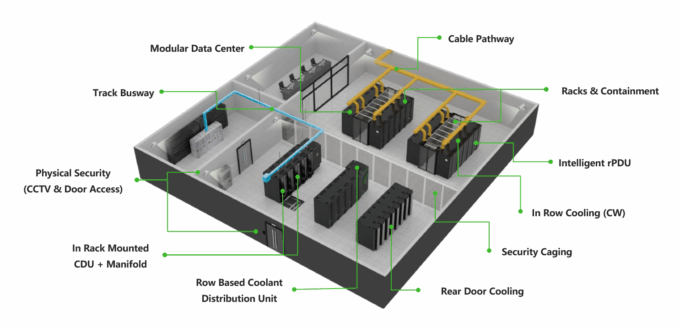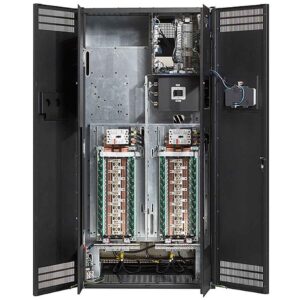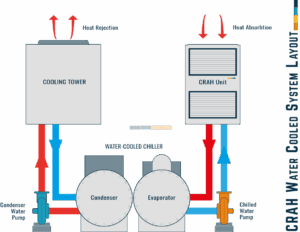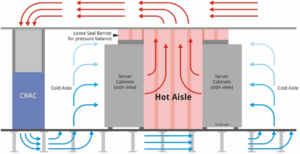Tier I Data Center Design Considerations for Architecture, Structural, and MEP Disciplines
Designing a Tier I data center requires balancing simplicity, cost, and essential reliability. While Tier I facilities offer the lowest level of redundancy, they serve as a critical foundation for small businesses and organizations entering the digital infrastructure space. This post outlines how each design discipline—Architecture, Structural, and MEP—contributes to building an efficient and maintainable Tier I data center.
Understanding Tier I Data Centers
Tier I facilities provide a single path for power and cooling without redundant systems. They achieve an average uptime of 99.671%, equating to roughly 28 hours of downtime per year. Maintenance or equipment failure causes service interruptions, so designers must focus on efficiency, maintainability, and future scalability.

Architectural Design Considerations
Architectural design begins by defining the white-space footprint for server racks, service aisles, and support zones.
Mechanical and electrical rooms should remain adjacent yet physically separated from IT spaces to reduce risk.
Next, designers organize a hot-aisle/cold-aisle layout to optimize cooling efficiency. Maintain clear aisle widths (1.2–1.5 m) and overhead or underfloor space for airflow and cabling.
Use durable, anti-static finishes and minimize dust accumulation through sealed surfaces and cleanable materials. Fire-rated partitions and doors should protect critical zones such as the generator room and fuel storage.
Finally, incorporate physical security controls—access card systems, CCTV, and visitor management—to safeguard IT assets. The architecture should also allow future expansion for mechanical or IT upgrades without major disruptions.

Structural Design Considerations
Structural design supports heavy equipment and ensures long-term serviceability. Start by sizing floors for high concentrated loads—typically around 150 psf for white-space areas.
Address point loads under server racks, UPS modules, and switchgear with appropriate slab thickness and reinforcement.
Vibration control is also vital; limit resonance near sensitive IT areas.
Provide coordinated openings and sleeves for conduits, cable trays, and piping. Include anchorage for all major equipment and comply with seismic and wind requirements.
Lastly, plan for future structural capacity, such as added rooftop units or raised floor modifications. Coordination with MEP and architectural teams ensures consistent clearances and efficient layouts.
MEP Design Considerations
Electrical Systems
Electrical design defines the backbone of a Tier I data center. Start with a single power distribution path feeding all critical equipment.
Select UPS, switchgear, and PDUs sized for full IT load, recognizing that Tier I provides no redundancy. Include a backup generator capable of supporting critical loads, with properly ventilated and fire-rated enclosures.
Implement a robust grounding and bonding system to protect sensitive electronics from electrical noise.
Even at Tier I, integrate basic power monitoring to track energy efficiency and anticipate future upgrades.
Mechanical Systems
Mechanical design focuses on dependable, straightforward cooling.
Use direct expansion (DX) or chilled-water systems with a single distribution path for conditioned air.
Arrange a hot-aisle/cold-aisle configuration to control air mixing. Air delivery can occur through raised floors or overhead ducts depending on the design strategy.
Include humidification and dehumidification controls to maintain ASHRAE environmental standards.
Provide access for equipment maintenance and ensure clearances for airflow and component removal.
Monitoring through a basic Building Management System (BMS) helps track temperature, humidity, and airflow performance. Plan piping and ductwork routes to allow simple future expansion or upgrades.
Designing for the Future
Although Tier I data centers offer limited redundancy, they serve as cost-effective stepping stones toward higher tiers. By emphasizing clear planning, robust construction, and scalable MEP systems, designers can future-proof facilities for gradual upgrades to Tier II or Tier III performance.
Conclusion
A well-designed Tier I data center balances practicality with reliability. Architects define secure and efficient layouts, structural engineers provide robust foundations, and MEP designers deliver reliable systems within a single-path framework. Together, these disciplines create a resilient environment that meets immediate needs while preparing for long-term growth. If you have any questions, please reach out to EVstudio’s Industrial A/E design specialists today!












